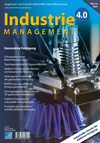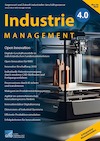Search


Bibtex
Cite as text
@Article{Papke+Bartels+Schmidt+Merklein,
Year= "2020",
Number= "4",
Volume= "36",
Pages= "50-54",
Journal = "Industrie 4.0 Management",
Title= "Additive Fertigung für industrielle Anwendungen: Entwicklung einer Auswahlsystematik für Bauteile zur Generierung funktionalen Mehrwerts mittels additiver Fertigung",
Author= "Thomas {Papke}, Dominic {Bartels}, Michael {Schmidt}, Marion {Merklein}",
Doi= "https://doi.org/10.30844/I40M_20-4_S50-54",
Abstract= "Durch hohe Gestaltungsfreiheit und den Entfall produktspezifischer Werkzeuge gewinnen additive Fertigungsprozesse im industriellen Umfeld immer stärker an Bedeutung. Mit der Ausnutzung der verfahrensspezifischen Vorteile gegenüber konventionellen Fertigungsverfahren kann ein Mehrwert für Bauteile und Produkte generiert werden. Allerdings stellt die Auswahl potenzieller Bauteile, die durch die additive Fertigung einen Mehrwert erhalten können, eine Herausforderung dar. Zu diesem Zweck wurde eine Auswahlsystematik erarbeitet, um das Potenzial zu quantifizieren. Darauf aufbauend wird ein Ansatz vorgestellt, mit welchem beginnend mit der Bauteilauswahl über die Bauteil- und Prozesskettengestaltung eine Bewertung des Mehrwerts möglich ist. Dieser wird abschließend auf ein Strukturbauteil eines Fahrzeugs angewendet.",
Keywords= "Additive Fertigung, Auswahlsystematik, Potenzialanalyse",
}
Thomas {Papke}, Dominic {Bartels}, Michael {Schmidt}, Marion {Merklein}(2020): Additive Fertigung für industrielle Anwendungen: Entwicklung einer Auswahlsystematik für Bauteile zur Generierung funktionalen Mehrwerts mittels additiver Fertigung. 364(2020), S. 50-54. Online: https://doi.org/10.30844/I40M_20-4_S50-54 (Abgerufen 24.12.25)
Open Access
Abstract
Abstract
Durch hohe Gestaltungsfreiheit und den Entfall produktspezifischer Werkzeuge gewinnen additive Fertigungsprozesse im industriellen Umfeld immer stärker an Bedeutung. Mit der Ausnutzung der verfahrensspezifischen Vorteile gegenüber konventionellen Fertigungsverfahren kann ein Mehrwert für Bauteile und Produkte generiert werden. Allerdings stellt die Auswahl potenzieller Bauteile, die durch die additive Fertigung einen Mehrwert erhalten können, eine Herausforderung dar. Zu diesem Zweck wurde eine Auswahlsystematik erarbeitet, um das Potenzial zu quantifizieren. Darauf aufbauend wird ein Ansatz vorgestellt, mit welchem beginnend mit der Bauteilauswahl über die Bauteil- und Prozesskettengestaltung eine Bewertung des Mehrwerts möglich ist. Dieser wird abschließend auf ein Strukturbauteil eines Fahrzeugs angewendet.
Keywords
Schlüsselwörter
Additive Fertigung, Auswahlsystematik, Potenzialanalyse
References
Referenzen
[1] Schmidt, M.; Merklein, M.; Bourell, D.; Dimitrov, D.; Hausotte, T.; Wegener, K.; Overmeyer, L.; Vollertsen, F.; Levy, G. N.: Laser based additive manufacturing in industry and academia. In: CIRP Annals 66 (2017), S. 561-583.
[2] Rosen, D. W.: Research supporting principles for design for additive manufacturing. In: Virtual and physical prototyping 9 (2014) 4, S. 225-232.
[3] Lindemann, C.; Reiher, T.; Jahnke, U.; Koch, R.: Towards a sustainable and economic selection of part candidates for additive manufacturing. In: Rapid Prototyping Journal 21 (2015) 2, S. 216-227.
[4] Mancanares, C. G.; Zancul, E. de S.; da Silva, J. C.; Miguel, P. A. C.: Additive manufacturing process selection based on parts‘ selection criteria. In: Int. Journal of Advanced Manufacturing Technologies 80 (2015), S. 1007-1014.
[5] Wortmann, N.; Jürgenhake, C.; Seidenberg, T.; Dumitrescu, R.; Krause, D.: Methodical approach for process selection in additive manufacturing. In: Int. Conf. on Engineering Design ICED19 (2019), S. 779-788.
[6] Gokuldoss, P. K.; Kolla, S.; Eckert, J.: Additive manufacturing processes: Selective Laser Melting, Electron Beam Melting and Binder Jetting – Selection Guidelines. In: materials 10 (2017) 672, S. 1-12.
[7] Kumke, M.; Watschke, H.; Hartogh, P.; Bavendiek, A.-K.; Vietor, T.: Methods and tools for identifying and leveraging additive manufacturing design potentials. In: Int. Journal of Interactive Design and Manufacturing 12 (2018), S. 481-493.
[8] Klahn, C.; Leutenecker, B.; Meboldt, M.: Design for Additive Manufacturing – Supporting the substitution of components in series products. In: Procedia CIRP 21 (2014), S. 138-143.
[9] Kumke, M.; Watschke, H.; Vietor, T.: A new methodological framework for design for additive manufacturing. In: Virtual and physical prototyping 11 (2016) 1, S. 3-19.
[10] Gläßner, C.; Yi, L.; Aurich, J. C.: Concept for development of additive process chains in manufacturing companies. In: Schmitt, R.; Schuh, G. (Hrsg): Advances in Production Research – Proceedings of the 8th Congress of the German Academic Association for Production Technology (WGP). Cham, Switzerland 2018.
[11] Yi, L.; Gläßner, C.; Aurich, J. C.: How to integrate additive manufacturing technologies into manufacturing systems successfully: A perspective from the commercial vehicle industry. In: Journal of Manufacturing Systems 53 (2019), S. 195-211.
[12] Thompson, M. K.; Stolfi, A.; Mischkot, M.: Process chain modelling and selection in an additive manufacturing context. In: CIRP Journal of Manufacturing Science and Technology 12 (2016), S. 25-34.
[13] Spalt, P.; Bauernhansl, T.: A framework for integration of additive manufacturing technologies in production networks. In: Procedia CIRP 57 (2016), S. 716-721.
[14] Zanardini, M.; Bacchetti, A.; Adrodegari, F.: Evaluation of technical and economic feasibility of additive manufacturing technology: evidences from a case study. In: Industrial Systems Engineering (2016), S. 6-11.
[15] Thomas, D. S.; Gillbert, S. W.: Costs and Cost Effectiveness of Additive Manufacturing – A Literature Review and Discussion. In: NIST Special Publication 1176. 2014.

 English
English